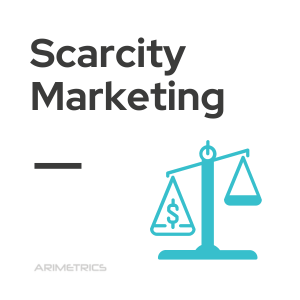Definition
Scarcity marketing is a marketing strategy that uses scarcity to create a sense of urgency in consumers and motivate them to take immediate action. This technique is based on the economic theory of supply and demand, where the scarcer a commodity is, the more valuable it becomes in the minds of consumers.
Shortages can manifest themselves in different ways, such as limiting the number of products available, offering a limited time offer, or even using psychological techniques such as creating waiting lists. The idea is to make consumers feel they need to act quickly before the supply runs out.
What is Scarcity marketing for?
Scarcity marketing uses scarcity to create urgency in consumers and encourage them to act quickly before stocks run out. Using this technique strategically and sparingly, you can increase sales and get customers to ask for more from your product.
The effectiveness of scarcity marketing is due to the human nature of wanting to own something that seems exclusive or difficult to obtain. This approach drives consumers to make impulse purchasing decisions and increases the chances that products will sell out quickly.
How to do scarcity marketing
Below we show applicable methodology:
- Identify the products or services that can be promoted through Scarcity Marketing. Products or services that are unique or difficult to obtain, or those that are in constant demand, are good candidates for this technique.
- Set a deadline for the promotion. For example, a special offer might be available only for a week or a weekend. The deadline should be clear and visible to consumers.
- Limit supply. You can limit the number of products or services available or limit the offer to a specific group of customers.
- Create a sense of urgency. Techniques such as counting the number of products left in stock or displaying a timer that shows the remaining time to take advantage of the offer can be used.
- Create a clear and engaging message. The message of the promotion should be clear and easy to understand, highlighting the scarcity of the product and what customers could lose if they don’t act quickly.
- Promote the offer in several channels. The offer must be promoted on social networks, email, online ads, etc. to reach a wide audience.
- Measure results and adjust strategy if necessary. Advocacy results should be tracked and strategy adjusted accordingly for greater success.
Scarcity Marketing examples:
Some examples of scarcity marketing:
- Limited time offers: A promotion where consumers can take advantage of exclusive discounts only for a limited time, can generate a sense of urgency and encourage customers to make a purchase quickly. For example, Amazon uses this technique during the annual Prime Day event, where it offers significant discounts on a wide variety of products for only two days.
- Limited quantity of products: When you limit the number of units of a product available, you can create greater demand and scarcity for it. A clear example of this is the sneaker industry, in which special editions are launched with a limited number of units available, creating a high level of demand and exclusivity.
- Creation of waiting lists: This technique can be very effective in the sale of highly exclusive or limited products. By creating a waiting list for these products, customers are more motivated to sign up and wait their turn to get them. It is common in the fashion industry, for example, for customers to sign up for waiting lists to purchase products from renowned designers such as Chanel or Louis Vuitton.
- Exclusive offers for VIP customers: When an exclusive promotion is offered only to a select group of customers, a sense of exclusivity and scarcity can be created. For example, some banks’ credit cards offer exclusive access to events or special discounts for their most loyal customers.
